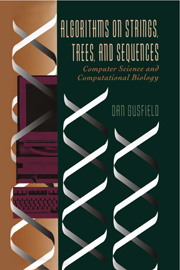III - Inexact Matching, Sequence Alignment, Dynamic Programming
Published online by Cambridge University Press: 23 June 2010
Summary
At this point we shift from the general area of exact matching and exact pattern discovery to the general area of inexact, approximate matching, and sequence alignment. “Approximate” means that some errors, of various types detailed later, are acceptable in valid matches. “Alignment” will be given a precise meaning later, but generally means lining up characters of strings, allowing mismatches as well as matches, and allowing characters of one string to be placed opposite spaces made in opposing strings.
We also shift from problems primarily concerning substrings to problems concerning subsequences. A subsequence differs from a substring in that the characters in a substring must be contiguous, whereas the characters in a subsequence embedded in a string need not be. For example, the string xyz is a subsequence, but not a substring, in axayaz. The shift from substrings to subsequences is a natural corollary of the shift from exact to inexact matching. This shift of focus to inexact matching and subsequence comparison is accompanied by a shift in technique. Most of the methods we will discuss in Part III, and many of the methods in Part IV, rely on the tool of dynamic programming, a tool that was not needed in Parts I and II.
Much of computational biology concerns sequence alignments
The area of approximate matching and sequence comparison is central in computational molecular biology both because of the presence of errors in molecular data and because of active mutational processes that (sub)sequence comparison methods seek to model and reveal.
- Type
- Chapter
- Information
- Algorithms on Strings, Trees and SequencesComputer Science and Computational Biology, pp. 209 - 211Publisher: Cambridge University PressPrint publication year: 1997
- 1
- Cited by



